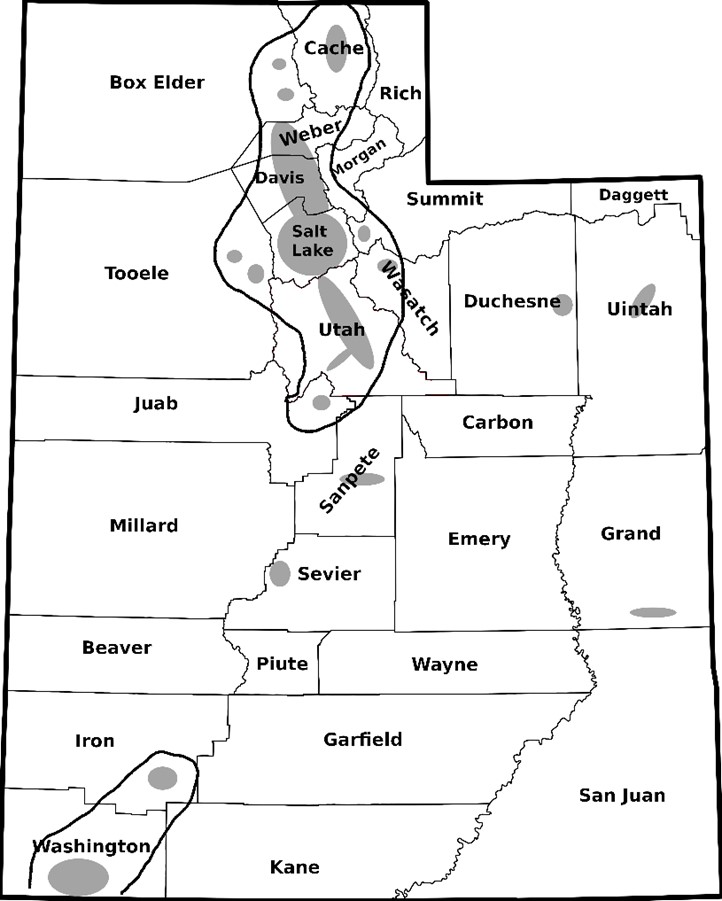Utah Dialect Regions and Features
Abstract
Data from the Utah Dialect Survey were used to delineate dialect boundaries in the state of Utah. Statistical algorithms divided the state into rural and urban dialect zones. Twelve features were identified that distinguish the two dialects. Three additional features were extracted from the the Harvard Survey of North American Dialects. The idea that the rural vs. urban divide is related to a greater number of immigrants to urban areas is discounted. Many rural features coincide with those used more by older Utahns suggesting that rural areas maintain more conservative Utah characteristics.
Downloads
References
Baker-Smemoe, Wendy, & David, B. (2015). Linguistic Behavior and Religious Activity. Language & Communication, 42, 116-124. https://doi.org/10.1016/j.langcom.2014.12.004
Baker, Wendy, David, E., & Lyndsey, N. (2009). Dialect Identification: The Effects of Region of Origin and Amount of Experience. American Speech, 84(1), 48-71. https://doi.org/10.1215/00031283-2009-004
Bezdek, J. C., Ehrlich, R., & Full, W. (1984). FCM: The fuzzy c-means clustering algorithm. Computers & Geosciences, 10(2-3), 191-203. https://doi.org/10.1016/0098-3004(84)90020-7
Blankenship, B. (1992). What TIMIT Can Tell Us About Epenthesis. UCLA Working Papers in Phonetics, 81, 17-25.
Bowie, D. (2003). Early Development of the Card-Cord Merger in Utah. American Speech, 78(1), 31-51.
DeBry, R. J., & Associates. (2109). These 11 Phrases Are a Dead Giveaway That You're from Utah. Deseret News. June 17. Retrieved from https://www.deseret.com/2019/6/21/20794577/these-11-phrases-are-a-dead-giveaway-that-you-re-from-utah.
DiPaolo, M. (1993). Propredicate Do in the English of the Intermountain West. American Speech, 68(4), 339-356. https://doi.org/10.2307/455771
Eddington, David, & Ellingson (2023 forthcoming). Utah English. Salt Lake City UT: University of Utah Press.
Eddington, David, & Matthew, S. (2012). Where Are the Moun[ʔə]ns in Utah? American Speech, 87, 336-349. https://doi.org/10.1215/00031283-1958345
Graham, J. (2006). 'Oh For' as a Scandinavian-influenced Linguistic Feature of Minnesota and Utah. (2006). Paper presented at the 60th Annual RMMLA Convention, Tucson, AZ, October 12-14.
Grieve, J., Speelman, D., & Geeraerts, D. (2011). A statistical method for the identification and aggregation of regional linguistic variation. Language Variation and Change, 23(2), 193-221. https://doi.org/10.1017/S095439451100007X
Holmes, G., Pfahringer, B., Kirkby, R., Frank, E., & Hall, M. (2002). Multiclass alternating decision trees. In European Conference on Machine Learning,161-172. Berlin, Heidelberg: Springer.
The Jamovi Project. (2020). Jamovi. V. 1.2. Linux/Mac/Windows. 2020. Retrieved from https://www.jamovi.org/about.html
JASP Team. (2022). JASP. V. 0.16.01. Retrieved from https://jasp-stats.org/
Lillie, D. D. (1998). The Utah Dialect Survey. Master’s thesis, Brigham Young University.
Lillie, D. D. Utah Dialects. Retrieved from http://www.geocities.ws/diandyl/udp/dialects.html
Nerbonne, J. (2009). Data‐driven dialectology. Language and Linguistics Compass, 3(1), 175-198. https://doi.org/10.1111/j.1749-818X.2008.00114.x
Pardoe, T. E. (1935). Some Studies of Rocky Mountain Dialects. Quarterly Journal of Speech, 21(3), 348-355. https://doi.org/10.1080/00335633509380117
R Core Team. R. (2020). A Language and Environment for Statistical Computing. V. 3.6. Linux/Mac/Windows, 2020.
Savage, D. M. (2014). How We Feel about How We Talk: A Language Attitude Survey of Utah English. Master’s thesis, Brigham Young University.
Seol, H. (2020). SnowCluster: Cluster Analysis. [jamovi module]. Retrieved from https://github.com.hyunsooseol/snowCluster
Séguy J. (1971). La relation entre la distance spatiale et la distance lexicale. Revue de Linguistique Romane 35, 335-357. http://doi.org/10.5169/seals-399508
Wikipedia. (2021). Wasatch Front. Last modified October 6. Retrieved from https://en.wikipedia.org/wiki/Wasatch_Front
Wikitravel. (2022). Wasatch Front. Last modified February 7. Retrieved from https://wikitravel.org/en/Wasatch_Front
World Population Review. (2020). Accessed December 30. https://worldpopulationreview.com/us-counties/states/ut
Yoo, I. W., & Blankenship, B. (2003). Duration of epenthetic [t] in polysyllabic American English words. Journal of the International Phonetic Association, 33(2), 153-164. https://doi.org/10.1017/S0025100303001269

Copyright for this article is retained by the author(s), with first publication rights granted to the journal.
This is an open-access article distributed under the terms and conditions of the Creative Commons Attribution license (http://creativecommons.org/licenses/by/4.0/).









1.png)









1.png)











